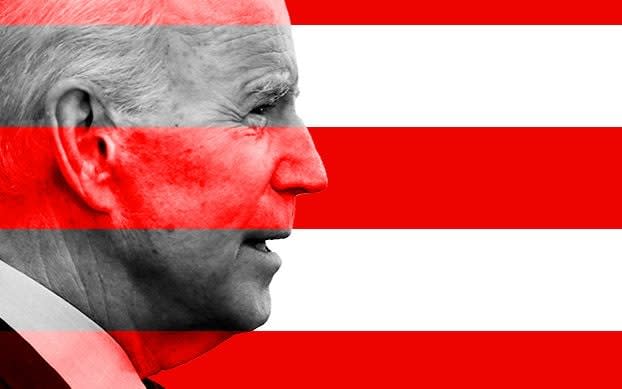Why Biden's $15 minimum wage may not help America
- Oops!Something went wrong.Please try again later.

Joe Biden is employing the Trojan Horse strategy to get many American workers their first pay rise in 12 years.
Hidden in the wooden belly of his $1.9 trillion (£1.4 trillion) stimulus plan will be something more ambitious than Covid support: the doubling of the federal minimum wage to $15 per hour. That would mark the first rise in the federal rate since 2009 and boost the wages of almost 30m Americans, analysis indicates.
“Nobody working 40 hours a week should be living below the poverty line,” Biden said last Thursday as he unveiled the proposals.
The plan has two major hitches. One is that such a large increase in the minimum wage is likely to encounter opposition in Congress where the Democrats hold a razor-thin majority in the Senate. The bill could end up being watered down or even blocked, albeit Democrats have hinted at using legislative workarounds.
Perhaps a bigger worry is whether such a sharp spike in wages will scupper the job market’s recovery – even if it’s spread out over years as Biden plans. However, many experts believe the new president can avoid a post-Covid jobs disaster.
“The evidence has been that increases in minimum wages in the UK and the US haven’t really had any significant impacts on employment overall,” says Tony Wilson, director of the Institute for Employment Studies.
“At the moment, the benefits outweigh the costs but obviously at some point that doesn’t hold. You can’t raise wages indefinitely without there being an impact on employment.”
Many states and cities have their own minimum wages higher than the national floor set by the government, with the likes of California, Florida and New York already planning to boost wages to $15 and above.
Yet that is not the case for most workers. Prior to Biden’s plans, up to 40pc of US workers were expected to be living in states where the minimum wage would still have been at $7.25 per hour in 2025, according to the Congressional Budget Office (CBO), which provides Congress with forecasts and economic information. Its 2019 report found that around two-thirds would live in states with minimum wages lower than Biden’s $15 proposal.
Rising wages, higher unemployment?
The CBO report estimated that the minimum wage being lifted to $15 by 2025 would boost pay for 17m Americans. The national floor would be at its highest point compared to overall pay since the early 1970s and a wage boost would also bump up pay for a further 10m workers earning slightly above $15.
But the CBO also warned that such a drastic hike in wages for many states could kill jobs - as many as 3.7m. Its median estimate calculated that 1.3m workers who would otherwise be employed in 2025 would not have a job. That could be an unwelcome headwind for the jobs market, with unemployment still at almost 7pc thanks to Covid.
“It will almost certainly depend on what the labour market is like, what the macroeconomic conditions are like and how big the increases are,” says Jonathan Cribb, economist at the Institute for Fiscal Studies.
“You would expect more negative impact in recessions.”
By making the US less competitive, the new president could struggle to woo factory jobs back from the likes of Mexico and Asia while hikes could tempt some employers to ditch low-paid jobs through automation. Higher labour costs would hit business owners and be passed on to consumers through an increase in prices, the CBO added.
Many countries, including the UK, Spain and France, have significantly lifted their wage floors in recent years. Fears of job losses in those countries have not been realised but the UK is pushing towards uncharted territory after some sharp hikes.
“We are already in a zone where we don’t know whether this could be a bad thing for employment,” says Cribb.
Keeping up with inflation
The Government plans to boost the National Living Wage to two-thirds of median earnings by 2024 and attracted criticism for pushing ahead with hikes during the pandemic.
“There’s definitely going to be a point where you’re going to start seeing net negative effects but we just don’t know where that point is,” says Andrew Aitken, economist at NIESR.
However, the long wait for a pay hike for many American workers means Biden’s plans may be less radical than many claim, with the last federal increase in 2009.
“It has not been increased for so long and of course in real terms it’s declined massively,” says Aitken.
“If you just imagine what it would be now had it been increased by the rate of inflation, it would probably already be closer to $15.”
While pushing up labour costs during the recovery is a gamble, Biden’s minimum wage boost may not be as perilous as many fear.
